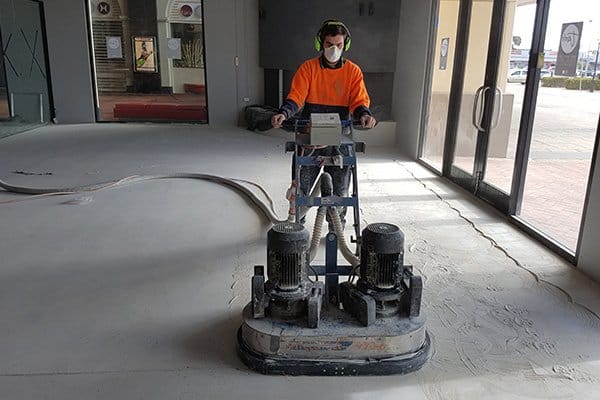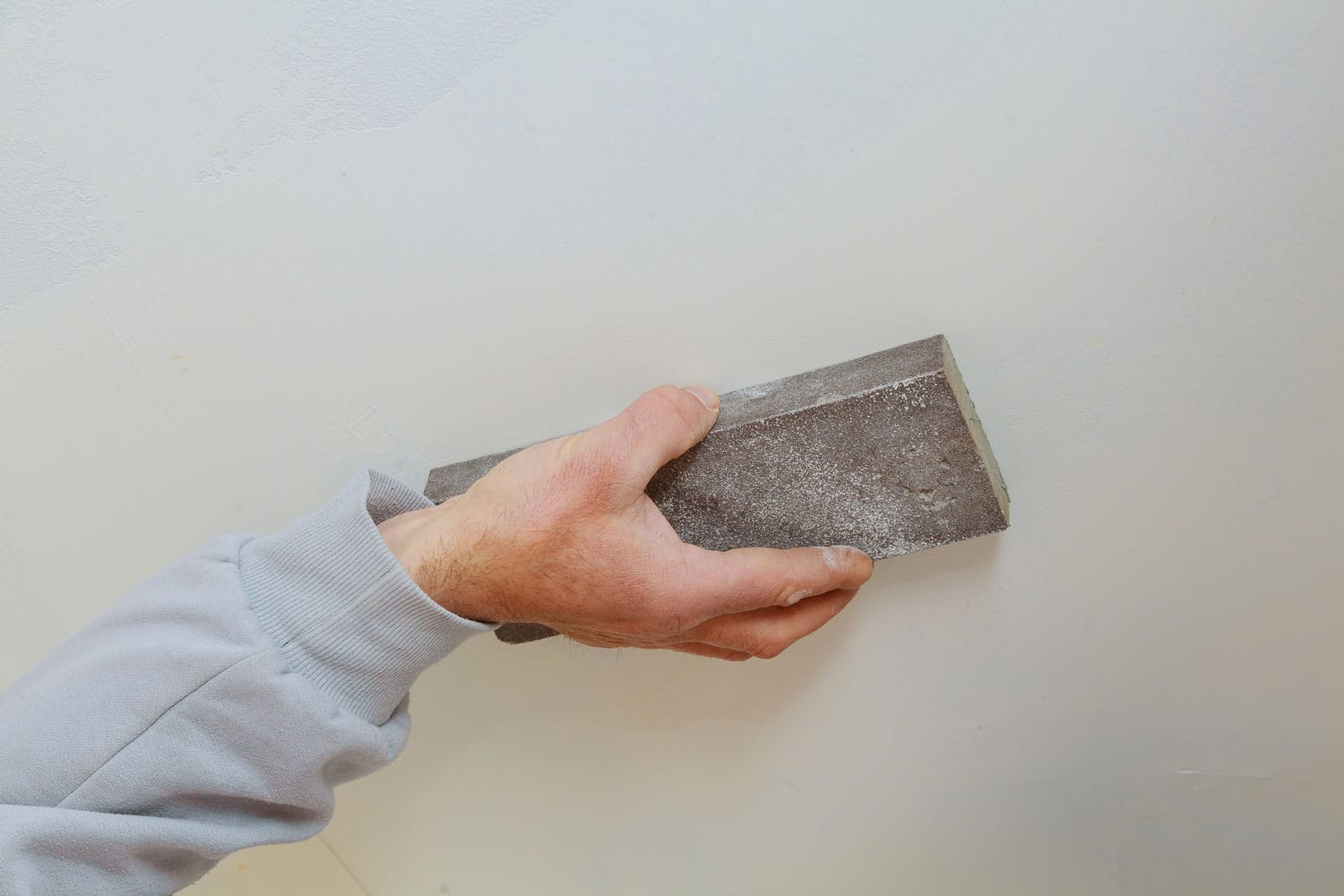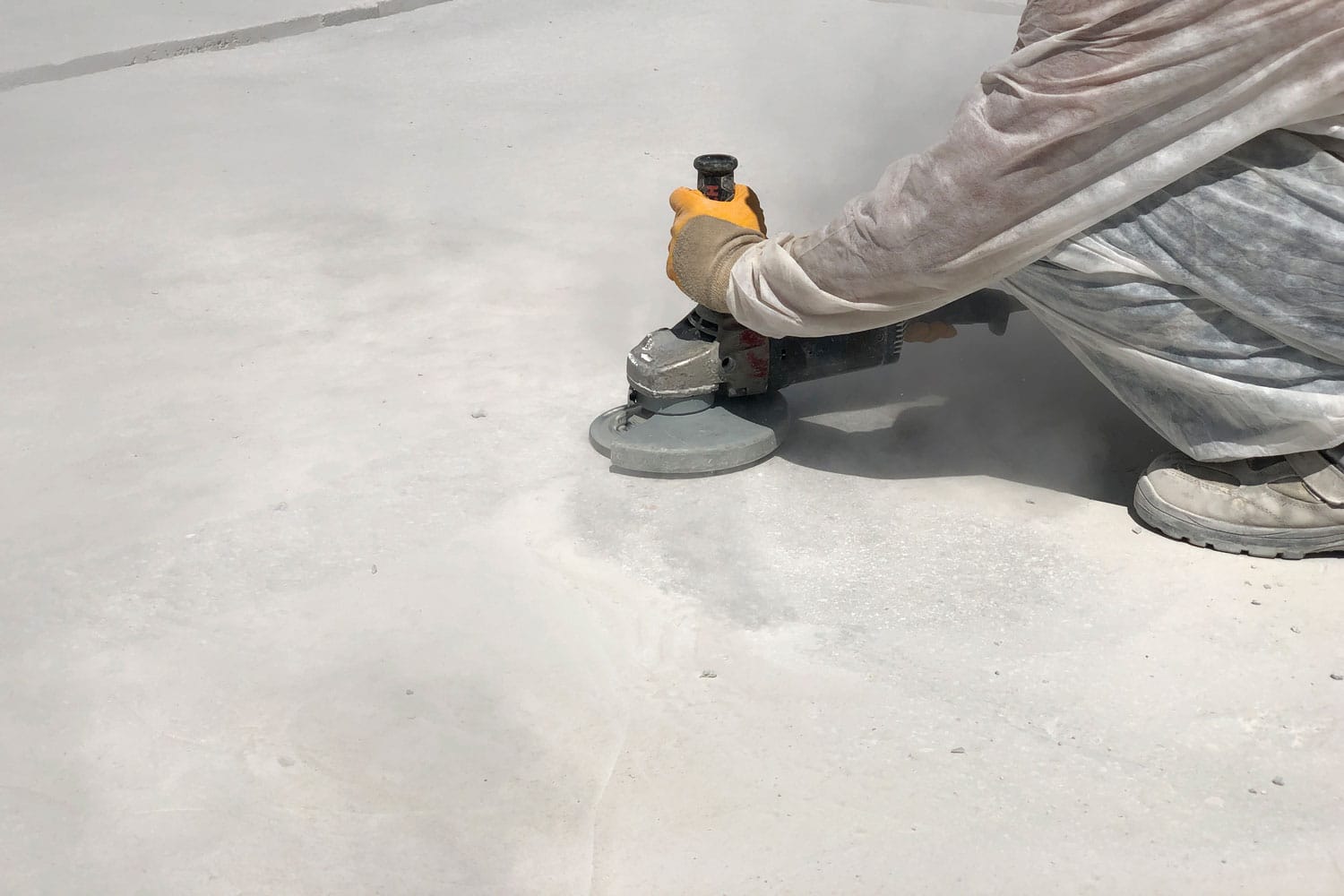A Complete Guide on Sanding Concrete

When it comes to home improvement projects, working with concrete can be both rewarding and challenging.
If you’re looking to refinish your concrete floors, create a smooth surface for painting, or repair cracks and imperfections, knowing how to sand concrete is a crucial skill. Here, we’ll walk you through the step-by-step process of sanding concrete to achieve professional results.
By following safety measures, selecting the right tools, and mastering the sanding process, you can beautify the shape and quality of your concrete surface sanding, resulting in attractive and durable outcomes.
Whether you’re a DIY fan or a professional contractor, this guide helps you with the knowledge and techniques to successfully concrete surface sanding with confidence.
Understanding the Basics of Sanding Concrete

Before starting the sanding process, it’s important to have a solid understanding of sanding concrete and why sanding is necessary. Concrete is a multipurpose and durable material made from cement, water and a mixture of sand and gravel.
Over time, concrete surfaces can become rough, uneven, or develop cracks due to factors such as wear and tear, weather exposure, and the settling of the concrete mix.
Sanding concrete involves using grinding materials to gradually grind down the surface, smooth out irregularities and create a more polished finish. This process not only improves the look of the concrete but also prepares it for various finishing treatments such as staining, painting, or sealing.
Can You Sand Concrete with Regular Sandpaper?

When it comes to sanding concrete, using regular sandpaper is not recommended. Concrete is a tough and abrasive material that requires specialized tools for effective sanding. Regular sandpaper is not designed to withstand the harsh nature of concrete, and it can quickly wear out or become clogged, making the sanding process kind of frustrating.
To achieve the best results, using sandpaper specifically made for concrete smoothing methods is important.
1. Use of Sandpaper Designed for Concrete
To sand concrete effectively, choose sandpaper that is created for Concrete polishing and sanding applications. Concrete sandpaper features a hard and durable construction that can go through the demands of smoothing and refining concrete surfaces.
It is created to prevent clogging and ensure a consistent rubbing action, allowing you to achieve a smoother finish. Using specialized concrete sandpaper increases the efficiency of the sanding process and helps you achieve more satisfactory results.
2. Different Grits for Various Levels of Material Removal
Concrete sandpaper comes in various grit levels, each designed for specific stages of the sanding process. Grit refers to the size of the abrasive particles on the sandpaper’s surface.
Lower grits, such as 30 or 40, are ideal for heavy material removal, such as leveling uneven surfaces or removing thick coatings. Medium grits, like 60 to 100, are suitable for Concrete polishing and sanding, while higher grits, such as 120 and above, are used for fine finishing and achieving a polished surface.
Choosing the right grit for your specific project ensures efficient material removal while avoiding excessive grinding.
Best Way to Sand Concrete
Sanding concrete is crucial for achieving a smooth and polished surface in various projects. Different tools are available for Concrete polishing and sanding, each serving a specific purpose.
Here’s a breakdown of the best ways to sand concrete and the appropriate applications for each tool:
1. Hand Sanding

Hand sanding is a basic Concrete smoothing method suitable for small areas or minor touch-ups. Use coarse-grit sandpaper for initial leveling, followed by finer grits for a smoother finish. It’s perfect for precise control and tackling edges and corners.
2. Belt Sander

A belt sander is excellent for larger surface areas. It uses a continuous loop of sandpaper, making it efficient for rapid material removal. Use this sanding concrete tool because it is the Best sanding tool for leveling uneven concrete, but be cautious not to apply too much pressure to prevent holes.
3. Angle Grinder

An angle grinder with a diamond cup wheel is ideal for heavy-duty tasks like removing thick coatings or adhesives. The rotating wheel allows aggressive material removal, but it requires a steady hand to avoid over-sanding.
4. Orbital Sander

An orbital sander outfitted with diamond or carbide sandpaper pads offers controlled sanding. This tool is suitable for achieving a smooth finish on both large and small surfaces, as well as for preparing concrete for staining or sealing.
5. Floor Concrete Grinder

For extensive projects or industrial settings, a floor concrete grinder is a go-to choice. It is manufactured to cover large areas efficiently, removing cracks and leaving a polished result. This Best sanding tool for concrete is commonly used for refinishing old concrete floors.
How to Sand Concrete Floors or Countertops

Sanding concrete floors or countertops can be a little challenging task, but with the right tools and techniques, you can achieve a smooth and polished finish. Sanding concrete floors or countertops can give them a fresh and smooth finish.
Step 1: Preparing the Room and Yourself
Before you begin, clear the area of any furniture or obstacles. Wear safety goggles, a dust mask, and sturdy gloves. Cover nearby items with plastic sheets to prevent dust from spreading.
Step 2: Inspecting and Repairing Concrete
Check the surface for cracks, holes, or uneven spots. Fill any gaps with a concrete patching compound and let it dry thoroughly. Smooth out rough patches with agrinder or chisel. A clean and even surface will yield better sanding results.
Step 3: Choosing Appropriate Sandpaper
Select the right type of sandpaper for your project.Rough grits are suitable for heavy-duty sanding to remove defects, while finer grits are used for smoothing and polishing. Start with a medium grit and work your way up.
Step 4: Sanding Concrete Process with Grit Progression
Begin with medium grit sandpaper and work in a circular or back-and-forth motion. Gradually move to finer grits, smoothing the surface as you go. Rinse the area with water to remove dust, allowing you to assess your progress. Repeat the process with finer grits until you achieve the desired smoothness.
Step 5: Applying a Hardener and Polishing
Once you’re satisfied with the smoothness, apply a concrete hardener to strengthen the surface. Let it cure according to the product instructions. To achieve a glossy finish, use a polishing machine with diamond polishing pads. Work through progressively finer pads for extra shine.
How to Sand Concrete Walls

1. Cleaning and Inspecting Walls
Before you start sanding your concrete walls, it’s crucial to clean and inspect them properly. Remove any dust, dirt, or loose particles using a broom or vacuum cleaner.
Inspect the walls for cracks, holes, or uneven surfaces. If you find any, patch them up with a concrete filler and let them dry thoroughly with the help of concrete sanding tools. This step ensures a smooth sanding process.
2. Sanding with a Handheld Grinder
Sanding concrete with a handheld grinder is the next step to get a polished look. Get a handheld grinder with a diamond cup wheel suitable for Concrete polishing and sanding.
Wear safety gear, including goggles, a dust mask, and gloves are the Concrete Sanding Tools. Fix the diamond cup wheel to the grinder securely. Make sure it’s centered and locked in place. Hold the grinder with both hands and apply even pressure. Begin sanding in a circular or back-and-forth motion, working on a small section at a time.
Gradually move the grinder over the entire wall, overlapping each pass slightly. Be patient and maintain consistent pressure for uniform results. Periodically stop and feel the wall’s texture. Once the surface feels smooth to the touch, you’re done sanding. Turn off the grinder and clean up the dust with a vacuum. Wipe down the walls to remove any remaining waste.
Why Should You Sand Concrete?

1. Improving Appearance
The Sanding Concrete smoothing method is an important step in improving the appearance of your surfaces. Over time, Concrete surface sanding can become rough, uneven, and discolored due to weathering, stains, or wear and tear.
Sanding helps to smoothen the surface, creating a polished and uniform look. It removes dirt and stubborn marks, revealing the true beauty of the concrete. Whether you’re refinishing a driveway, patio, or indoor flooring, sanding restores the original luster and finish, making your spaces more beautiful.
2. Making Surfaces Safer
Safety is a top priority, especially when it comes to concrete surfaces. Rough and uneven concrete can pose tripping hazards, leading to accidents. Sanding eliminates these dangers by providing a level and slip-resistant texture. It smooths out uneven spots that may collect water or ice, reducing the risk of slips and falls. By sanding your concrete, you create a safer environment for passersby and ensure a worry-free experience, whether it’s a walkway, pool deck, or garage floor.
3. Ensuring Smooth Repairs
When it’s time to repair or resurface concrete, sanding plays a vital role. It prepares the surface for new layers of concrete or other coatings, ensuring proper pasting and a smooth finish. By sanding, you remove old sealants, paint, or damaged layers, allowing the new material to bond effectively. This step prevents peeling, cracking, or uneven patches in your repairs.
Whether you’re fixing cracks or performing a complete service, sanding paves the way for successful Concrete surface sanding restoration.
Benefits of Sanding Concrete

Sanding concrete is a flexible process that offers a range of benefits, changing various surfaces like terraces and countertops. Whether you want to improve the design, ensure safety, or achieve a plain look after repairs, sanding concrete is your go-to solution.
1. Improves the Look
Sanding concrete breathes new life into tired surfaces. Patios, countertops, and other concrete features often develop unsightly wear and tear over time.
By sending it, you can smooth out scratches, revealing the natural beauty of the material. The process opens the door to creativity, allowing you to stain or polish the concrete for a polished, bright look.
2. Eliminating Dangerous Edges and Uneven Parts
Uneven concrete surfaces pose a safety issue. Sanding levels out these irregularities, creating a uniform plane that reduces the risk of tripping and falling. Sharp edges can also be smoothed down through sanding, making your space safer for both family and guests.
3. Removing Paint Effectively
Concrete surfaces with old, peeling paint could look dirty. Sanding efficiently removes paint layers, preparing the surface for a fresh coat or other treatments. This step is essential for a proper bond between new finishes and the concrete, ensuring longevity.
4. Achieving a Smooth, Uniform Look After Repairs
When Concrete smoothing methods undergo repairs, they often leave behind unsightly patches or uneven textures. Sanding helps blend these repaired areas easily into the surrounding surface. The process ensures consistent checks, making it difficult to distinguish between original and repaired sections.
Conclusion
All in all, understanding the basics of concrete and the importance of sanding is key to achieving polished and safe surfaces. Sanding concrete increases appearance, making spaces more attractive by smoothing out chips and bringing their natural beauty.
Moreover, it promotes safety by removing risk and creating slip-resistant textures. When repairs are needed, sanding makes smooth joints and durability of new coatings.
To make sand concrete effectively, specialized tools like power sanders and grinders are used, while regular sandpaper is not recommended due to concrete’s toughness.
Select concrete-specific sandpaper with varying grits ensures efficient material removal and a smoother finish. From small touch-ups to larger projects, choosing the right tool for the job, like handheld grinders or orbital sanders, is crucial.
By following proper steps and safety measures, sanding concrete floors and walls can transform spaces into polished, inviting, and safer environments.
Frequently Asked Questions
Can I Sand Concrete by Hand?
Yes, you can sand concrete by hand using sandpaper or rubbing pads. However, using a powered sander is more efficient for larger areas.
Is Concrete Dust Harmful?
Yes, concrete dust can be hazardous if inhaled. It’s crucial to wear proper protective gear and work in a well-ventilated area.
Can I Sand Concrete with Regular Sandpaper?
Regular sandpaper is not suitable for sanding concrete due to its hardness. Use sandpaper specifically designed for concrete surfaces.
How Long Does the Concrete Need to Cure Before Sanding?
Concrete should be cured for at least 7 days before sanding. However, waiting 28 days ensures optimal hardness.
Can I Polish Concrete without Sanding?
Sanding is typically a prerequisite for concrete polishing, as it levels the surface and removes imperfections.



